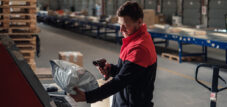Concepts for efficient warehousing in the mail order business
Language selection 📢
Published on: February 13, 2016 / update from: March 6, 2021 - Author: Konrad Wolfenstein
introduction
Efficient warehousing has long since become a critical success factor for mail order companies. It's no wonder that companies in the industry are constantly striving to further optimize their intralogistics processes for efficiency. The type of storage plays a special role; It is crucial for the quick and precise picking of the ordered goods. In addition to the fixed storage system, dynamic warehousing has established itself as a proven solution among the major providers. Below we would like to briefly introduce and compare the concepts.
Another question facing mail order companies is the decision between setting up centralized or decentralized distribution centers in which they store their goods and pick them for shipping. We deal with this problem in the second part of the text.
But no matter how a company ultimately decides, whether for a fixed storage system or chaotic warehousing, whether for centralized or decentralized distribution centers; You will always have to choose between the various rack storage systems available on the market. At companies in whose warehouses employees scan the goods with scanners and
When picking up picklists, you often find simple shelving solutions that are not particularly high (keyword: handle height) so that the items can be easily stored and removed by employees. Systems of this type are relatively unproblematic and inexpensive to install, but have the disadvantage that they require a lot of space per square meter due to the limited storage height and therefore space. for large companies like Otto or Amazon , as they can afford to build huge distribution centers on greenfield sites. For smaller providers or for retailers who have several, decentralized and not quite as large warehouses, the question naturally arises as to how as many goods as possible can be stored efficiently in a limited space.
This is where modern high-bay warehouses, paternoster and other lift systems come into play, allowing retailers to optimally store and pick their products in a small space. Due to the large number of possible variations regarding the dimensions of the automatic high racks, their shelf heights and depths and the diverse software solutions, companies are able to develop a concept tailored to their spatial conditions and requirements in detail with these devices. The latest generation of shuttle systems can also load entire pallets, which are placed in the trays using an integrated lifting crane. It is therefore not surprising that more and more online trading companies are now considering purchasing such storage solutions, which initially require considerable investments, but quickly make up for them through their high efficiency in storage and provision.
Chaotic warehousing vs. fixed storage
In contrast to fixed storage, in which the items are assigned fixed and long-term locations, dynamically controlled storage space allocation is based on a flexible structure. This is often referred to as chaotic storage , and although the term dynamic storage space allocation is a more accurate description for this system, the term chaotic storage has become fixed in most people's minds. We will therefore also refer to this solution as this below.
At first glance, it does indeed look chaotic to the observer when the goods are stored in a haphazard manner on the shelves. But there is a sophisticated system behind it. A system that looks anything but chaotic for warehouse management software and at the same time helps to control the flow of goods across a wide range of products very effectively. Since online retail often operates with a wide range of products and the number of items in stock is often not very high, the form of chaotic storage is particularly interesting for this industry. This is probably one reason why big players like Amazon or Zalando in particular operate with this type of warehousing in their logistics centers.
How chaotic warehousing works
The chaotic warehousing is intended to lead to an optimized utilization of the usable space in the warehouse and thus represents the “intelligent” counterpart to the fixed storage system. While in a conventional warehouse every item has its fixed place and is stored in the same place every time after a new order and delivery, The chaotic variant lacks this fixed assignment.
When new goods are stored, an employee in the warehouse looks for the free shelf space indicated by the mobile data device that is always at hand. Like every product, every individual storage location is clearly marked with a barcode. The warehouse worker scans these codes using the data reader carried along and informs the warehouse management software that the corresponding item is now in the intended position on the shelf. If the item is later requested again because it was ordered by a customer, this information is retrieved from the ERP system and automatically added to a pick list, which sends the employee to the shelf location where the item in question is stored according to the database for picking . If the product is removed from the shelf, a new scan is carried out, which informs the software that a free space has been created at that point.
The starting point for choosing one of the two alternative types of storage is the question of greater efficiency, although the decision is almost of existential importance, especially for large mail order companies with their huge storage quantities and wide product range.
Would you like an example? Mail order company But what happens if the item is sold out? From then on, the storage space assigned to him is empty until the ordered goods arrive. At the same time, there is a large number of product Z in the goods receipt that cannot be placed in its original space because it is already full. However, she cannot use the free space for product Y because it is reserved for this product Y. The retailer's incoming goods are therefore overflowing, even though parts of the warehouse remain empty.
And this is exactly where the chaotic storage begins. chaotic mean that the items are lying around haphazardly and unsorted, so that in the end no one knows where the products are stored. Rather, it means that, according to a sophisticated system, a new, perhaps completely different item is assigned to every free storage space that becomes available. However, this allocation is no longer controlled by humans, but rather by warehouse management software that trims the flow of goods for efficiency. Strictly speaking, the chaotic solution is based on a much more complex system than fixed storage.
However, the system is largely dependent on the functioning software, as all storage locations on the shelves and all items are provided with barcodes so that they can be stored optimally by the warehouse workers and found again later. The barcodes are therefore of vital importance for a functioning system, as they record all relevant information about the item or the storage location. In addition to information such as item name, item number, etc., countless information about size, volume, weight or durability is stored. The appropriate storage strategy is then created based on this information.
The information is read and accessed via employees' mobile scanning devices. With the help of the warehouse management software, employees are always informed about which item has been stored in which location and which storage location is currently empty and can be refilled. For example, if an employee wants to store a new item, the software suggests the optimal storage location based on the information available. If necessary, items can also be stored depending on their importance. In this way, items that sell particularly frequently are assigned places that are easier and quicker to reach than items that sell less frequently and are therefore visited less frequently by workers.
No wonder that warehouse management software plays a crucial role in controlling and monitoring the flow of goods. By assigning batch and serial number management, it also makes it possible to track the path of each individual item from incoming and outgoing goods and beyond.
Requirements for chaotic storage
In order not to lose track when assigning items to storage locations, it is necessary
- All items are marked digitally and legibly (usually by barcode)
- all inventory movements of items and their locations are recorded digitally
- the products must be similar in terms of their storage requirements (e.g. in terms of temperature, humidity)
- Warehouse management software is available that can be used to monitor and control the flow of goods
- the software works flawlessly, because if the electronic control system fails, the entire inventory would have to be determined manually, which would take a lot of effort
The items are often classified based on the so-called ABC classification: Items that are often called up (so-called fast-moving items , group A) are positioned in the places where they can be reached most quickly - usually only on pallets close to the points where the goods are picked become. Goods from the B group, which are called up in smaller quantities, are placed in central positions in the warehouse, where they can also be easily picked up. Items ordered less often (Group C) are ultimately stored in a rear area of the warehouse.
In practice, this type of storage without a fixed allocation can only be used for items with a long shelf life. Perishable goods (e.g. food in cold storage rooms) or products that have to be stored under certain conditions (e.g. electronic components in drying cabinets) must be treated separately. In practice, there are therefore mixed concepts in which some of the stocks are stored chaotically in open areas, while the rest are assigned fixed locations in the warehouse.
Compared to the rigid fixed area system, chaotic storage has the following advantages :
- Time savings through quick storage and retrieval : when new items are delivered, the warehouse management software assigns them directly to an empty storage location without the warehouse worker having to look for a free space
- Maximum utilization of capacity : the space is optimally utilized through the direct and immediate storage of new goods in free storage spaces. Empty storage areas are minimized
- Efficient picking : the warehouse management software always determines the most efficient processes for each individual item. This shortens employees' journeys, which conserves energy and saves time. As a result, more orders can be completed.
- Flexibility : it is much easier to react to changes or quantitative fluctuations in the product range. This also reduces the planning effort, because neither the product range nor the exact sales quantities need to be planned or even known in advance.
- Short acclimatization of employees : the intelligent control shortens the training times for employees compared to the fixed station system. With a fixed storage solution, employees literally have to learn the storage locations in order to be able to work efficiently. With the chaotic concept, the organization of the warehouse or individual item locations do not need to be known, as this step is taken care of by the software.
In summary, chaotic warehousing offers mail order companies more efficient storage solutions and, through its digital control, ensures better control and transparency over the flow of goods within the company. Although its name suggests the opposite, the chaotic storage solution is more systematically structured in form than the fairground system.
It just seems chaotic to people. For the computer, however, it is intelligent!
Centralized vs. decentralized warehouse centers
In addition to the question of individually harmonious warehousing, companies in the e-commerce sector are also faced with the problem of the geographical arrangement of their storage and picking centers. Two opposing tendencies collide here: centralized or decentralized storage of goods.
Central storage
Since they are responsible for supplying a significantly larger catchment area and therefore a lot more goods have to be kept ready, central storage solutions are usually significantly larger in terms of volume than the decentralized units.
Advantages
- Simplification : The argument in favor of setting up central distribution centers is that the intralogistics processes are simplified because storage and retrieval or picking takes place in just one or a small number of locations.
- Automation : Due to the size of the systems, it is often worthwhile to automate the warehouse processes, which leads to cost advantages and higher picking speeds.
- Handling : Warehouse management is also easier to handle in a distribution center that is concentrated in one location with regard to the procurement of machines, storage systems and control software.
- Space requirement : In addition, the provider saves space because, overall, he has to keep a smaller inventory than if he had to stock a large number of warehouses.
Disadvantages
- Delivery times : However, in addition to the high investment in a location, this solution has the disadvantage that there are comparatively long delivery times due to the long delivery routes.
- Flexibility : The central warehouse lacks the flexibility that smaller centers scattered across the sales area have.
Decentralized storage
In addition to flexibility and shortened delivery routes, the concept also has some disadvantages. Due to limited space, it is often not possible to keep the entire range of items available. On the other hand, certain items must be available in certain quantities in all warehouses, which unnecessarily increases the total amount of inventory stored. Warehouse management is also more difficult with several decentralized units than with a single warehouse complex. In addition, with the smaller warehouse size, it is often not possible to use automation technologies economically, which weakens the order picking performance and at the same time results in additional manual work.
Finally, if an item is not available locally and has to be procured from one of the other warehouses, this inevitably leads to longer overall delivery times than with the central solution.
Depending on the weighting of the priorities, each company must decide individually for one or the other option. If the focus is more on ultra-short delivery times (same day delivery) or if either perishable goods or a manageable, fast-moving number of goods are offered, decentralized storage is an option. If, on the other hand, you operate with a large depth of goods and trade with products that should reach the customer within 24 to 48 hours, the company should consider storing them in central distribution centers due to the cost advantages.
Why Xpert.Plus ?
Xpert.Plus is a project from Xpert.Digital. We have many years of experience in supporting and advising on storage solutions and in logistics optimization, which we bundle in a large network Xpert.Plus
I would be happy to serve as your personal advisor.
You can contact me by filling out the contact form below or simply call me on +49 89 89 674 804 (Munich) .
I'm looking forward to our joint project.
Xpert.Digital – Konrad Wolfenstein
Xpert.Digital is a hub for industry with a focus on digitalization, mechanical engineering, logistics/intralogistics and photovoltaics.
With our 360° business development solution, we support well-known companies from new business to after sales.
Market intelligence, smarketing, marketing automation, content development, PR, mail campaigns, personalized social media and lead nurturing are part of our digital tools.
You can find out more at: www.xpert.digital – www.xpert.solar – www.xpert.plus































